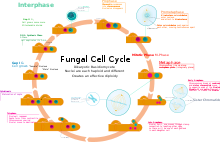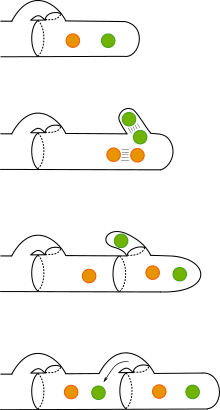Clamp connection

A clamp connection is a hook-like structure formed by growing
ascomycetes.[1]
Formation


Clamp connections are formed by the terminal hypha during elongation. Before the clamp connection is formed this terminal segment contains two nuclei. Once the terminal segment is long enough it begins to form the clamp connection. At the same time, each nucleus undergoes
mitotic division to produce two daughter nuclei. As the clamp continues to develop it uptakes one of the daughter (green circle) nuclei and separates it from its sister nucleus. While this is occurring the remaining nuclei (orange circles) begin to migrate from one another to opposite ends of the cell. Once all these steps have occurred a septum forms, separating each set of nuclei.[2]
Use in classification
Clamp connections are structures unique to the phylum
Fossil record
A fungal mycelium containing abundant clamp connections was found that dated to the
Ma.[6]
References
- ISBN 0-471-52229-5
- ^ "Clamp Connection Formation". hawaii.edu.
- ^ Kuo M. "Using a Microscope: Clamp Connections". MushroomExpert.Com. Retrieved 2010-12-15.
- ^ Furtado, João S. (1966). "Significance of the clamp-connection in the basidiomycetes". Persoonia. 4 (1): 125–144.
- JSTOR 3757529.
- S2CID 86132001.
